Public Health Leadership and Management: A Comparative Analysis
VerifiedAdded on 2021/04/17
|10
|2674
|91
Report
AI Summary
This report delves into the evolving landscape of public health leadership and management. It begins by differentiating between leaders and managers, outlining their distinct roles and responsibilities within the public health sector. The report then contrasts the public health industry with others, highlighting the unique challenges and expectations placed on leaders and managers. Through interviews with public health leaders, the report provides real-world insights into their motivations, challenges, and perspectives on leadership. The report also includes a self-assessment of the author's leadership style using a leadership skills inventory, analyzing strengths and weaknesses. Overall, the report offers a comprehensive overview of leadership in public health, emphasizing the importance of effective leadership for improving community health outcomes and the need for leaders to adapt to changing public health needs.
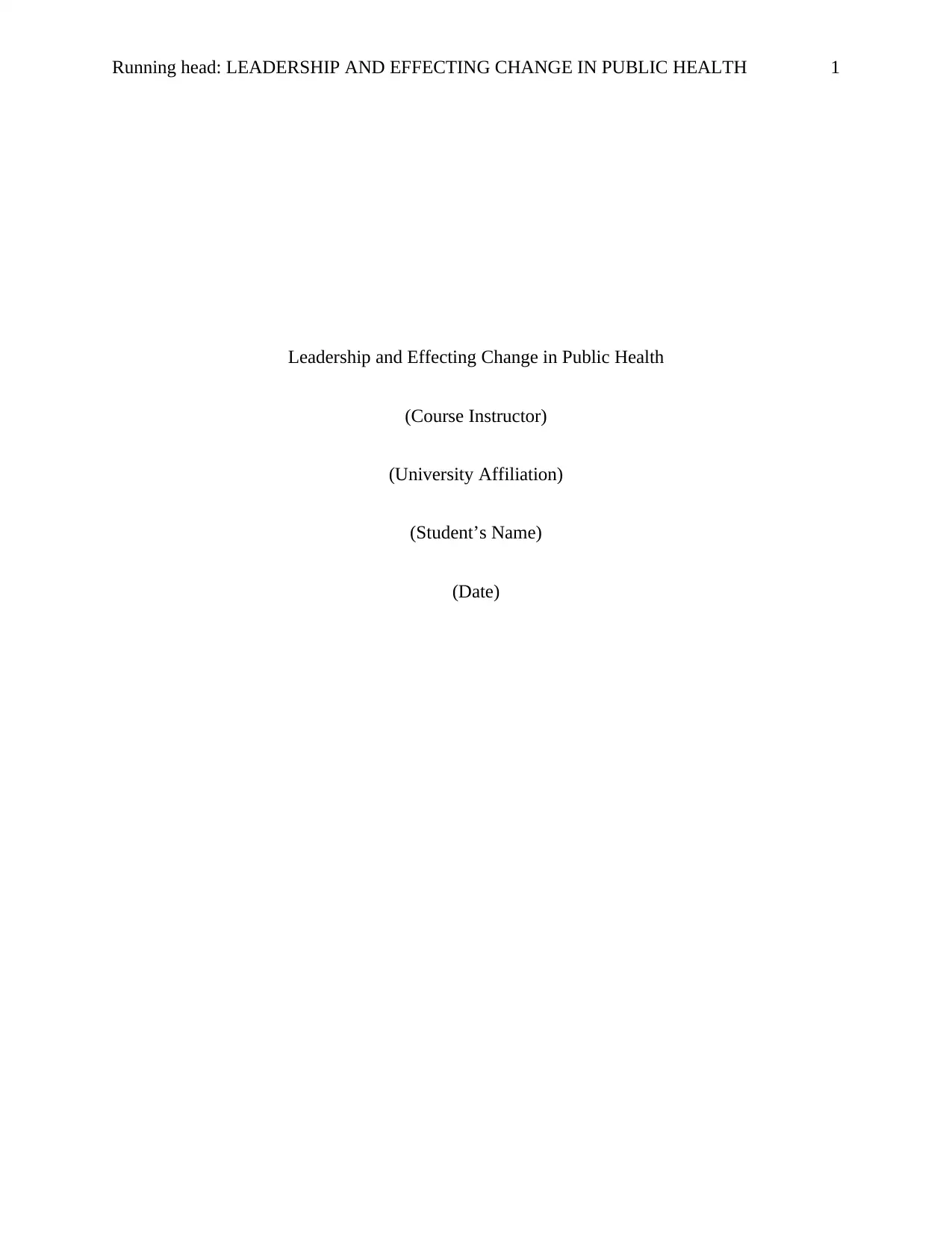
Running head: LEADERSHIP AND EFFECTING CHANGE IN PUBLIC HEALTH 1
Leadership and Effecting Change in Public Health
(Course Instructor)
(University Affiliation)
(Student’s Name)
(Date)
Leadership and Effecting Change in Public Health
(Course Instructor)
(University Affiliation)
(Student’s Name)
(Date)
Paraphrase This Document
Need a fresh take? Get an instant paraphrase of this document with our AI Paraphraser
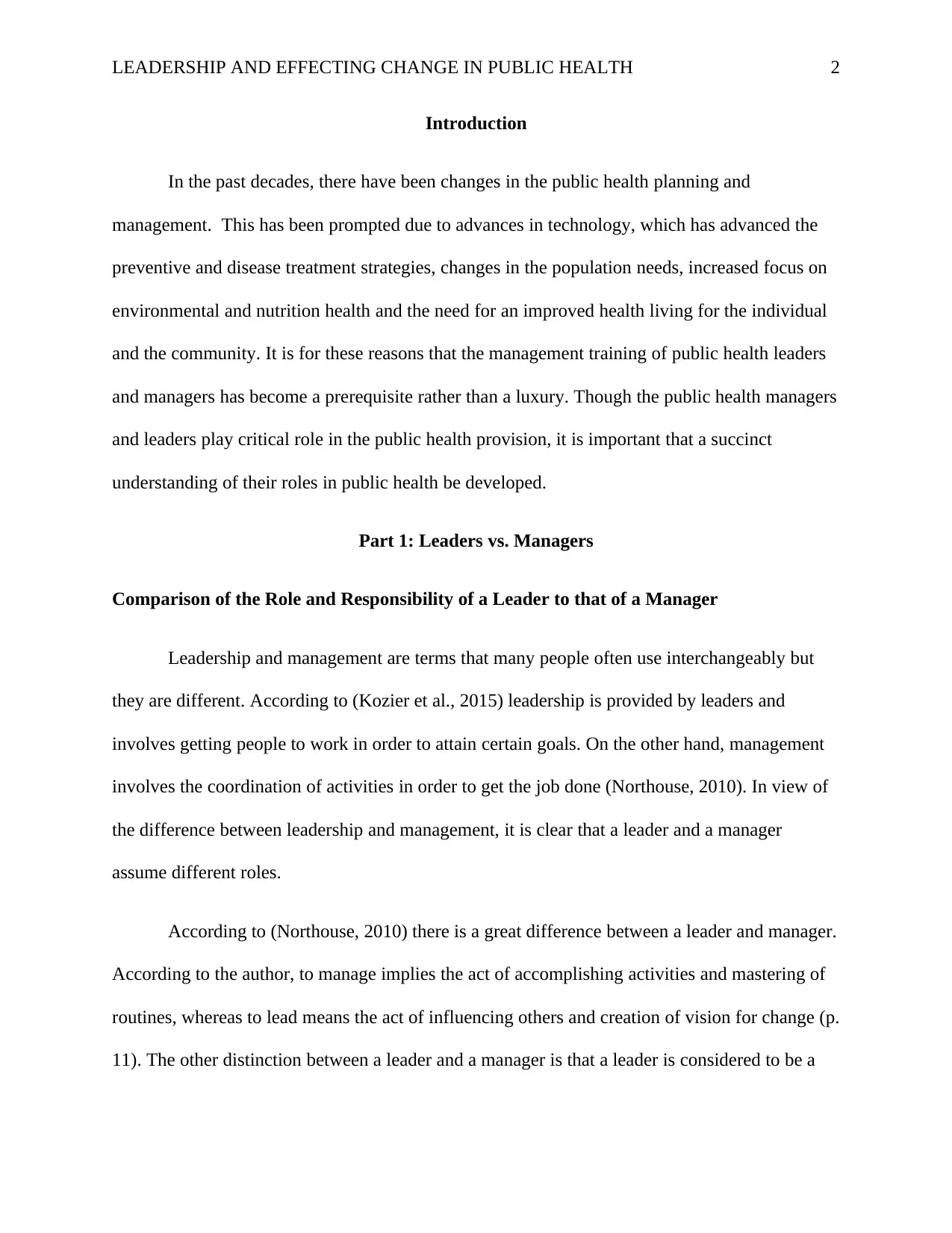
LEADERSHIP AND EFFECTING CHANGE IN PUBLIC HEALTH 2
Introduction
In the past decades, there have been changes in the public health planning and
management. This has been prompted due to advances in technology, which has advanced the
preventive and disease treatment strategies, changes in the population needs, increased focus on
environmental and nutrition health and the need for an improved health living for the individual
and the community. It is for these reasons that the management training of public health leaders
and managers has become a prerequisite rather than a luxury. Though the public health managers
and leaders play critical role in the public health provision, it is important that a succinct
understanding of their roles in public health be developed.
Part 1: Leaders vs. Managers
Comparison of the Role and Responsibility of a Leader to that of a Manager
Leadership and management are terms that many people often use interchangeably but
they are different. According to (Kozier et al., 2015) leadership is provided by leaders and
involves getting people to work in order to attain certain goals. On the other hand, management
involves the coordination of activities in order to get the job done (Northouse, 2010). In view of
the difference between leadership and management, it is clear that a leader and a manager
assume different roles.
According to (Northouse, 2010) there is a great difference between a leader and manager.
According to the author, to manage implies the act of accomplishing activities and mastering of
routines, whereas to lead means the act of influencing others and creation of vision for change (p.
11). The other distinction between a leader and a manager is that a leader is considered to be a
Introduction
In the past decades, there have been changes in the public health planning and
management. This has been prompted due to advances in technology, which has advanced the
preventive and disease treatment strategies, changes in the population needs, increased focus on
environmental and nutrition health and the need for an improved health living for the individual
and the community. It is for these reasons that the management training of public health leaders
and managers has become a prerequisite rather than a luxury. Though the public health managers
and leaders play critical role in the public health provision, it is important that a succinct
understanding of their roles in public health be developed.
Part 1: Leaders vs. Managers
Comparison of the Role and Responsibility of a Leader to that of a Manager
Leadership and management are terms that many people often use interchangeably but
they are different. According to (Kozier et al., 2015) leadership is provided by leaders and
involves getting people to work in order to attain certain goals. On the other hand, management
involves the coordination of activities in order to get the job done (Northouse, 2010). In view of
the difference between leadership and management, it is clear that a leader and a manager
assume different roles.
According to (Northouse, 2010) there is a great difference between a leader and manager.
According to the author, to manage implies the act of accomplishing activities and mastering of
routines, whereas to lead means the act of influencing others and creation of vision for change (p.
11). The other distinction between a leader and a manager is that a leader is considered to be a
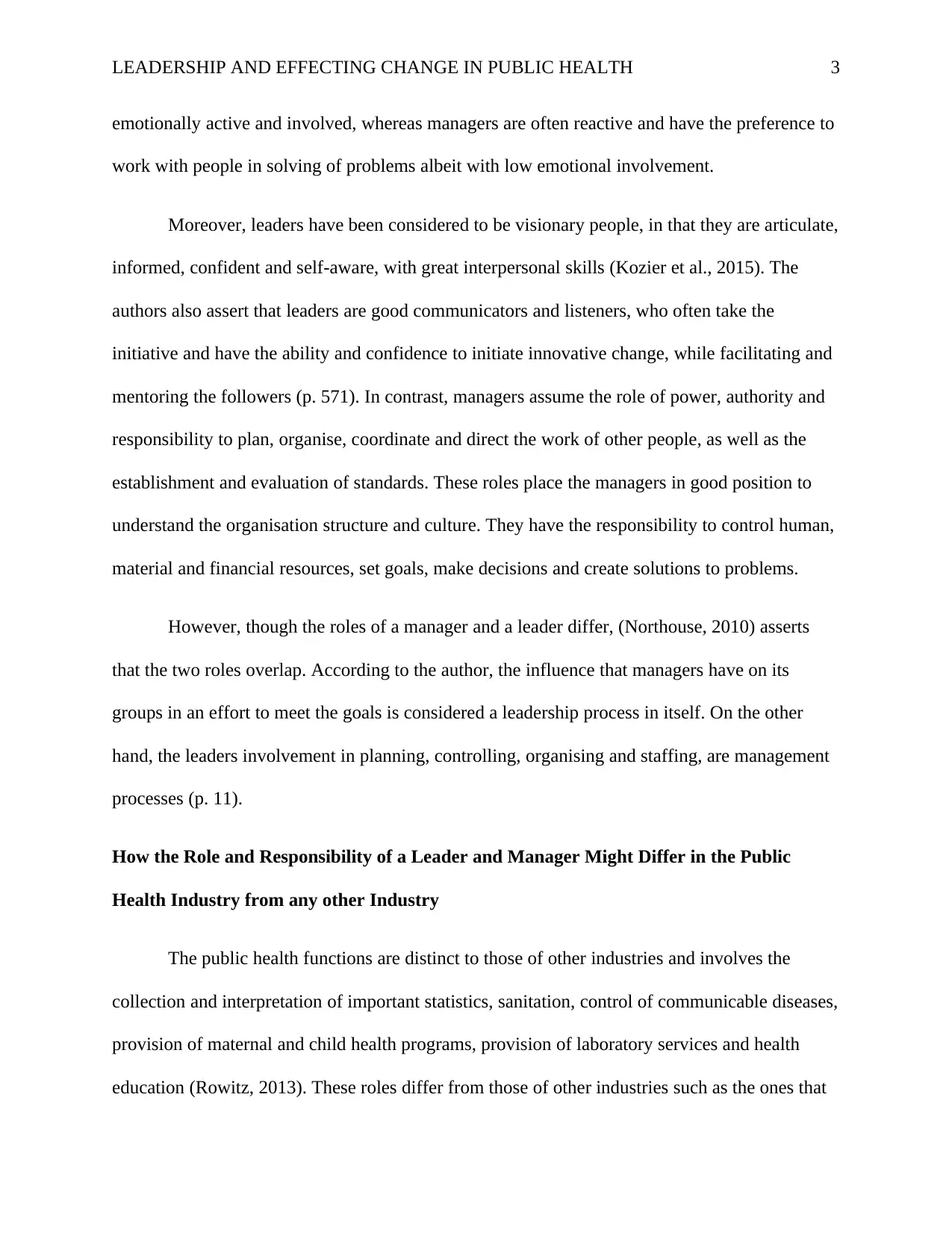
LEADERSHIP AND EFFECTING CHANGE IN PUBLIC HEALTH 3
emotionally active and involved, whereas managers are often reactive and have the preference to
work with people in solving of problems albeit with low emotional involvement.
Moreover, leaders have been considered to be visionary people, in that they are articulate,
informed, confident and self-aware, with great interpersonal skills (Kozier et al., 2015). The
authors also assert that leaders are good communicators and listeners, who often take the
initiative and have the ability and confidence to initiate innovative change, while facilitating and
mentoring the followers (p. 571). In contrast, managers assume the role of power, authority and
responsibility to plan, organise, coordinate and direct the work of other people, as well as the
establishment and evaluation of standards. These roles place the managers in good position to
understand the organisation structure and culture. They have the responsibility to control human,
material and financial resources, set goals, make decisions and create solutions to problems.
However, though the roles of a manager and a leader differ, (Northouse, 2010) asserts
that the two roles overlap. According to the author, the influence that managers have on its
groups in an effort to meet the goals is considered a leadership process in itself. On the other
hand, the leaders involvement in planning, controlling, organising and staffing, are management
processes (p. 11).
How the Role and Responsibility of a Leader and Manager Might Differ in the Public
Health Industry from any other Industry
The public health functions are distinct to those of other industries and involves the
collection and interpretation of important statistics, sanitation, control of communicable diseases,
provision of maternal and child health programs, provision of laboratory services and health
education (Rowitz, 2013). These roles differ from those of other industries such as the ones that
emotionally active and involved, whereas managers are often reactive and have the preference to
work with people in solving of problems albeit with low emotional involvement.
Moreover, leaders have been considered to be visionary people, in that they are articulate,
informed, confident and self-aware, with great interpersonal skills (Kozier et al., 2015). The
authors also assert that leaders are good communicators and listeners, who often take the
initiative and have the ability and confidence to initiate innovative change, while facilitating and
mentoring the followers (p. 571). In contrast, managers assume the role of power, authority and
responsibility to plan, organise, coordinate and direct the work of other people, as well as the
establishment and evaluation of standards. These roles place the managers in good position to
understand the organisation structure and culture. They have the responsibility to control human,
material and financial resources, set goals, make decisions and create solutions to problems.
However, though the roles of a manager and a leader differ, (Northouse, 2010) asserts
that the two roles overlap. According to the author, the influence that managers have on its
groups in an effort to meet the goals is considered a leadership process in itself. On the other
hand, the leaders involvement in planning, controlling, organising and staffing, are management
processes (p. 11).
How the Role and Responsibility of a Leader and Manager Might Differ in the Public
Health Industry from any other Industry
The public health functions are distinct to those of other industries and involves the
collection and interpretation of important statistics, sanitation, control of communicable diseases,
provision of maternal and child health programs, provision of laboratory services and health
education (Rowitz, 2013). These roles differ from those of other industries such as the ones that
⊘ This is a preview!⊘
Do you want full access?
Subscribe today to unlock all pages.

Trusted by 1+ million students worldwide
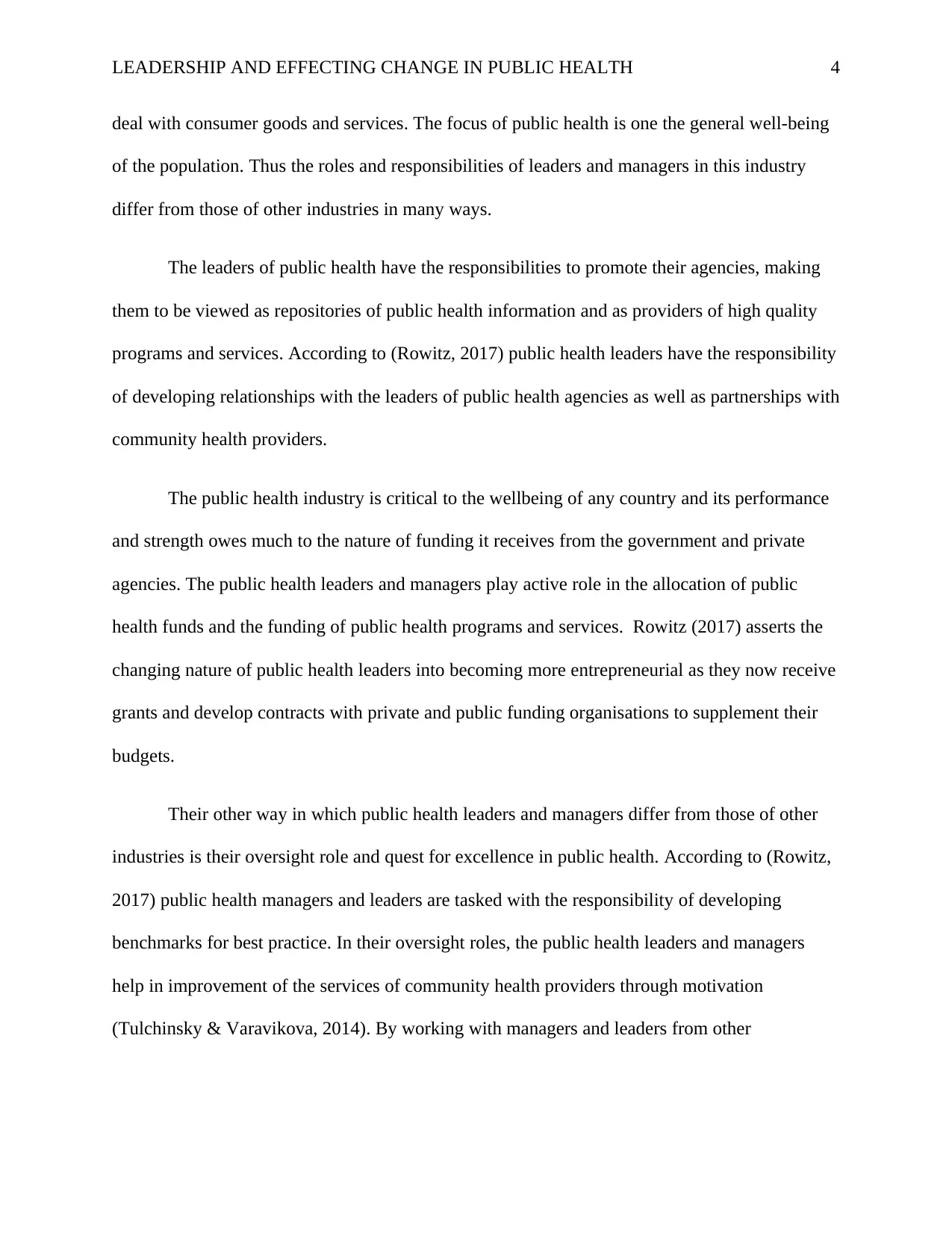
LEADERSHIP AND EFFECTING CHANGE IN PUBLIC HEALTH 4
deal with consumer goods and services. The focus of public health is one the general well-being
of the population. Thus the roles and responsibilities of leaders and managers in this industry
differ from those of other industries in many ways.
The leaders of public health have the responsibilities to promote their agencies, making
them to be viewed as repositories of public health information and as providers of high quality
programs and services. According to (Rowitz, 2017) public health leaders have the responsibility
of developing relationships with the leaders of public health agencies as well as partnerships with
community health providers.
The public health industry is critical to the wellbeing of any country and its performance
and strength owes much to the nature of funding it receives from the government and private
agencies. The public health leaders and managers play active role in the allocation of public
health funds and the funding of public health programs and services. Rowitz (2017) asserts the
changing nature of public health leaders into becoming more entrepreneurial as they now receive
grants and develop contracts with private and public funding organisations to supplement their
budgets.
Their other way in which public health leaders and managers differ from those of other
industries is their oversight role and quest for excellence in public health. According to (Rowitz,
2017) public health managers and leaders are tasked with the responsibility of developing
benchmarks for best practice. In their oversight roles, the public health leaders and managers
help in improvement of the services of community health providers through motivation
(Tulchinsky & Varavikova, 2014). By working with managers and leaders from other
deal with consumer goods and services. The focus of public health is one the general well-being
of the population. Thus the roles and responsibilities of leaders and managers in this industry
differ from those of other industries in many ways.
The leaders of public health have the responsibilities to promote their agencies, making
them to be viewed as repositories of public health information and as providers of high quality
programs and services. According to (Rowitz, 2017) public health leaders have the responsibility
of developing relationships with the leaders of public health agencies as well as partnerships with
community health providers.
The public health industry is critical to the wellbeing of any country and its performance
and strength owes much to the nature of funding it receives from the government and private
agencies. The public health leaders and managers play active role in the allocation of public
health funds and the funding of public health programs and services. Rowitz (2017) asserts the
changing nature of public health leaders into becoming more entrepreneurial as they now receive
grants and develop contracts with private and public funding organisations to supplement their
budgets.
Their other way in which public health leaders and managers differ from those of other
industries is their oversight role and quest for excellence in public health. According to (Rowitz,
2017) public health managers and leaders are tasked with the responsibility of developing
benchmarks for best practice. In their oversight roles, the public health leaders and managers
help in improvement of the services of community health providers through motivation
(Tulchinsky & Varavikova, 2014). By working with managers and leaders from other
Paraphrase This Document
Need a fresh take? Get an instant paraphrase of this document with our AI Paraphraser
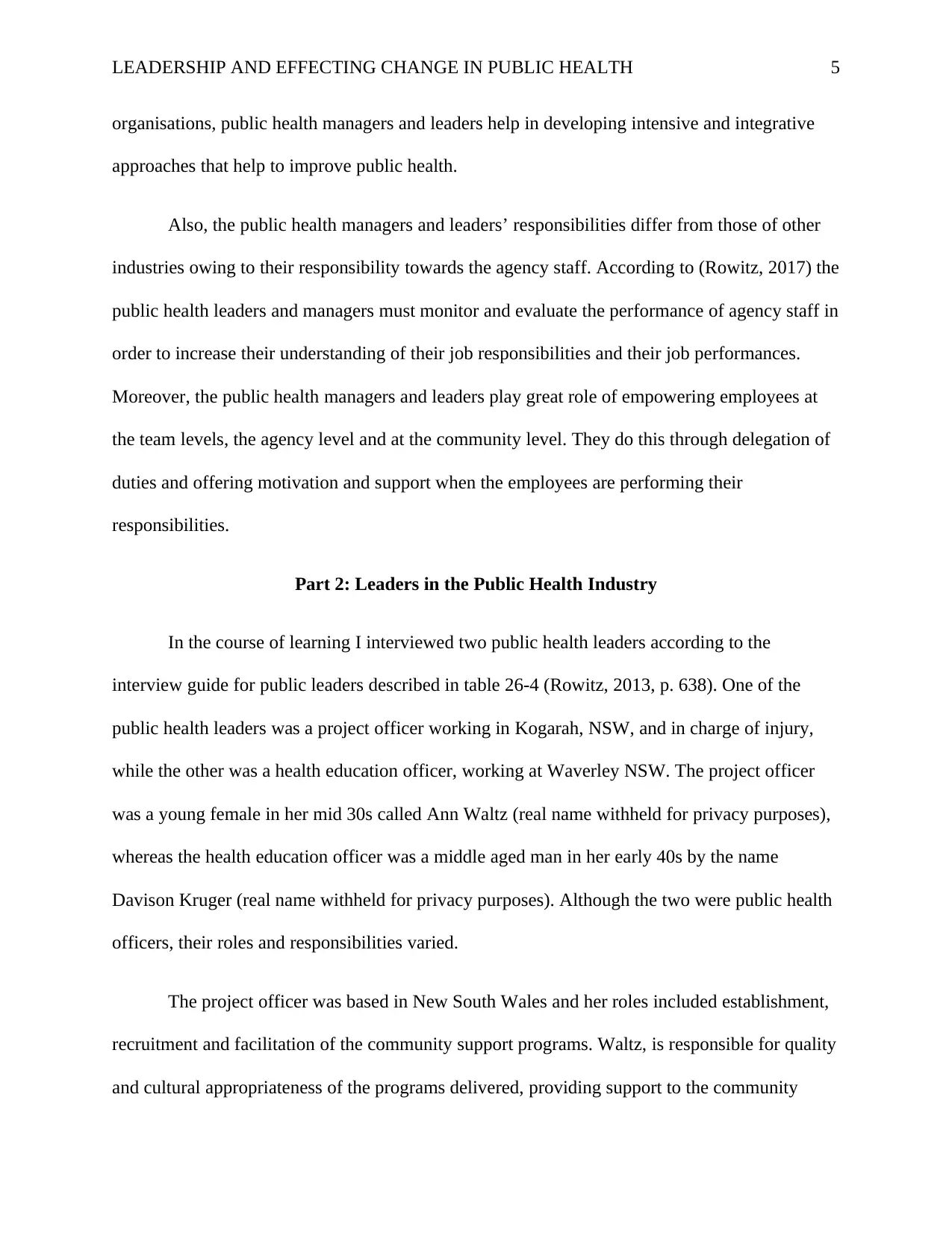
LEADERSHIP AND EFFECTING CHANGE IN PUBLIC HEALTH 5
organisations, public health managers and leaders help in developing intensive and integrative
approaches that help to improve public health.
Also, the public health managers and leaders’ responsibilities differ from those of other
industries owing to their responsibility towards the agency staff. According to (Rowitz, 2017) the
public health leaders and managers must monitor and evaluate the performance of agency staff in
order to increase their understanding of their job responsibilities and their job performances.
Moreover, the public health managers and leaders play great role of empowering employees at
the team levels, the agency level and at the community level. They do this through delegation of
duties and offering motivation and support when the employees are performing their
responsibilities.
Part 2: Leaders in the Public Health Industry
In the course of learning I interviewed two public health leaders according to the
interview guide for public leaders described in table 26-4 (Rowitz, 2013, p. 638). One of the
public health leaders was a project officer working in Kogarah, NSW, and in charge of injury,
while the other was a health education officer, working at Waverley NSW. The project officer
was a young female in her mid 30s called Ann Waltz (real name withheld for privacy purposes),
whereas the health education officer was a middle aged man in her early 40s by the name
Davison Kruger (real name withheld for privacy purposes). Although the two were public health
officers, their roles and responsibilities varied.
The project officer was based in New South Wales and her roles included establishment,
recruitment and facilitation of the community support programs. Waltz, is responsible for quality
and cultural appropriateness of the programs delivered, providing support to the community
organisations, public health managers and leaders help in developing intensive and integrative
approaches that help to improve public health.
Also, the public health managers and leaders’ responsibilities differ from those of other
industries owing to their responsibility towards the agency staff. According to (Rowitz, 2017) the
public health leaders and managers must monitor and evaluate the performance of agency staff in
order to increase their understanding of their job responsibilities and their job performances.
Moreover, the public health managers and leaders play great role of empowering employees at
the team levels, the agency level and at the community level. They do this through delegation of
duties and offering motivation and support when the employees are performing their
responsibilities.
Part 2: Leaders in the Public Health Industry
In the course of learning I interviewed two public health leaders according to the
interview guide for public leaders described in table 26-4 (Rowitz, 2013, p. 638). One of the
public health leaders was a project officer working in Kogarah, NSW, and in charge of injury,
while the other was a health education officer, working at Waverley NSW. The project officer
was a young female in her mid 30s called Ann Waltz (real name withheld for privacy purposes),
whereas the health education officer was a middle aged man in her early 40s by the name
Davison Kruger (real name withheld for privacy purposes). Although the two were public health
officers, their roles and responsibilities varied.
The project officer was based in New South Wales and her roles included establishment,
recruitment and facilitation of the community support programs. Waltz, is responsible for quality
and cultural appropriateness of the programs delivered, providing support to the community
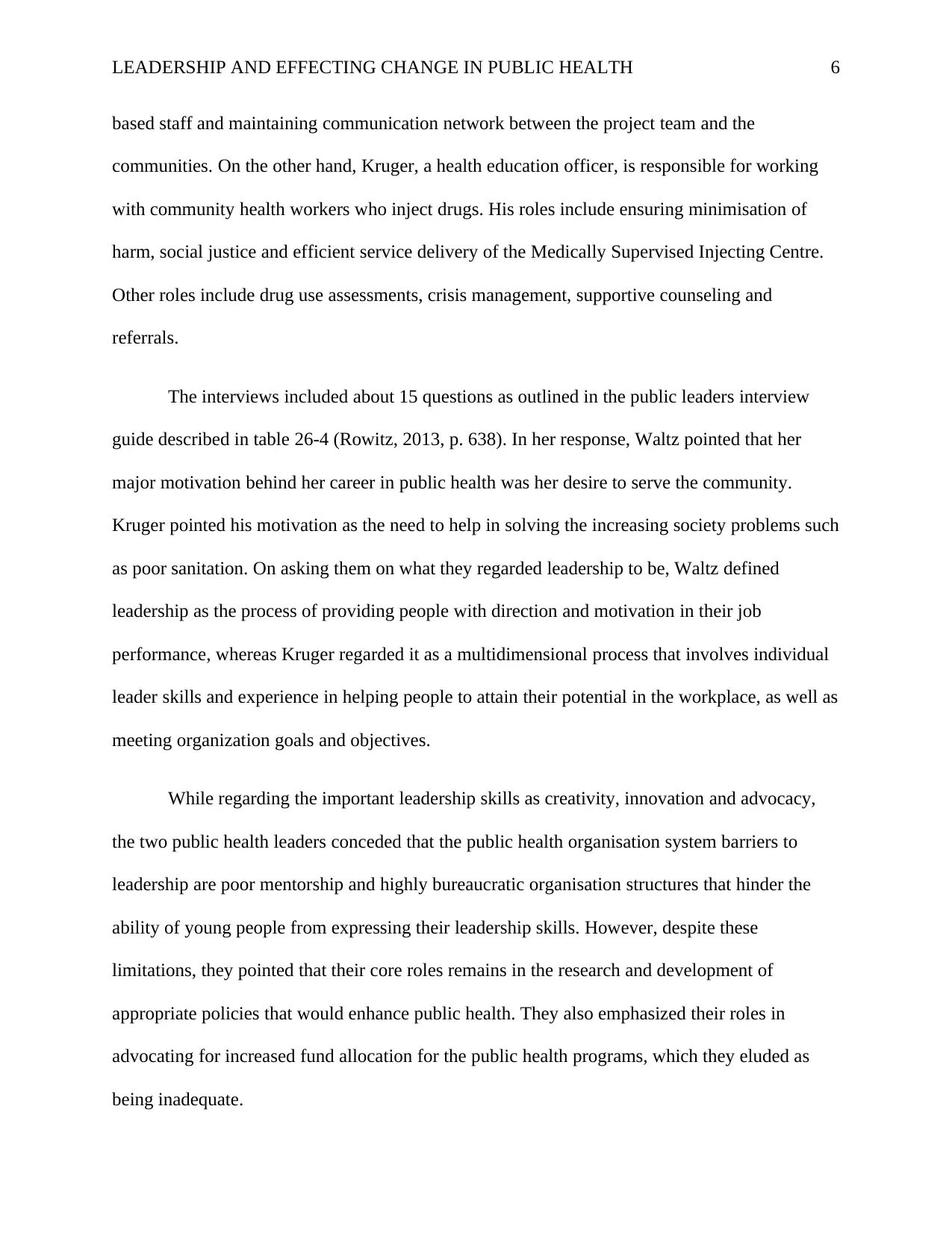
LEADERSHIP AND EFFECTING CHANGE IN PUBLIC HEALTH 6
based staff and maintaining communication network between the project team and the
communities. On the other hand, Kruger, a health education officer, is responsible for working
with community health workers who inject drugs. His roles include ensuring minimisation of
harm, social justice and efficient service delivery of the Medically Supervised Injecting Centre.
Other roles include drug use assessments, crisis management, supportive counseling and
referrals.
The interviews included about 15 questions as outlined in the public leaders interview
guide described in table 26-4 (Rowitz, 2013, p. 638). In her response, Waltz pointed that her
major motivation behind her career in public health was her desire to serve the community.
Kruger pointed his motivation as the need to help in solving the increasing society problems such
as poor sanitation. On asking them on what they regarded leadership to be, Waltz defined
leadership as the process of providing people with direction and motivation in their job
performance, whereas Kruger regarded it as a multidimensional process that involves individual
leader skills and experience in helping people to attain their potential in the workplace, as well as
meeting organization goals and objectives.
While regarding the important leadership skills as creativity, innovation and advocacy,
the two public health leaders conceded that the public health organisation system barriers to
leadership are poor mentorship and highly bureaucratic organisation structures that hinder the
ability of young people from expressing their leadership skills. However, despite these
limitations, they pointed that their core roles remains in the research and development of
appropriate policies that would enhance public health. They also emphasized their roles in
advocating for increased fund allocation for the public health programs, which they eluded as
being inadequate.
based staff and maintaining communication network between the project team and the
communities. On the other hand, Kruger, a health education officer, is responsible for working
with community health workers who inject drugs. His roles include ensuring minimisation of
harm, social justice and efficient service delivery of the Medically Supervised Injecting Centre.
Other roles include drug use assessments, crisis management, supportive counseling and
referrals.
The interviews included about 15 questions as outlined in the public leaders interview
guide described in table 26-4 (Rowitz, 2013, p. 638). In her response, Waltz pointed that her
major motivation behind her career in public health was her desire to serve the community.
Kruger pointed his motivation as the need to help in solving the increasing society problems such
as poor sanitation. On asking them on what they regarded leadership to be, Waltz defined
leadership as the process of providing people with direction and motivation in their job
performance, whereas Kruger regarded it as a multidimensional process that involves individual
leader skills and experience in helping people to attain their potential in the workplace, as well as
meeting organization goals and objectives.
While regarding the important leadership skills as creativity, innovation and advocacy,
the two public health leaders conceded that the public health organisation system barriers to
leadership are poor mentorship and highly bureaucratic organisation structures that hinder the
ability of young people from expressing their leadership skills. However, despite these
limitations, they pointed that their core roles remains in the research and development of
appropriate policies that would enhance public health. They also emphasized their roles in
advocating for increased fund allocation for the public health programs, which they eluded as
being inadequate.
⊘ This is a preview!⊘
Do you want full access?
Subscribe today to unlock all pages.

Trusted by 1+ million students worldwide
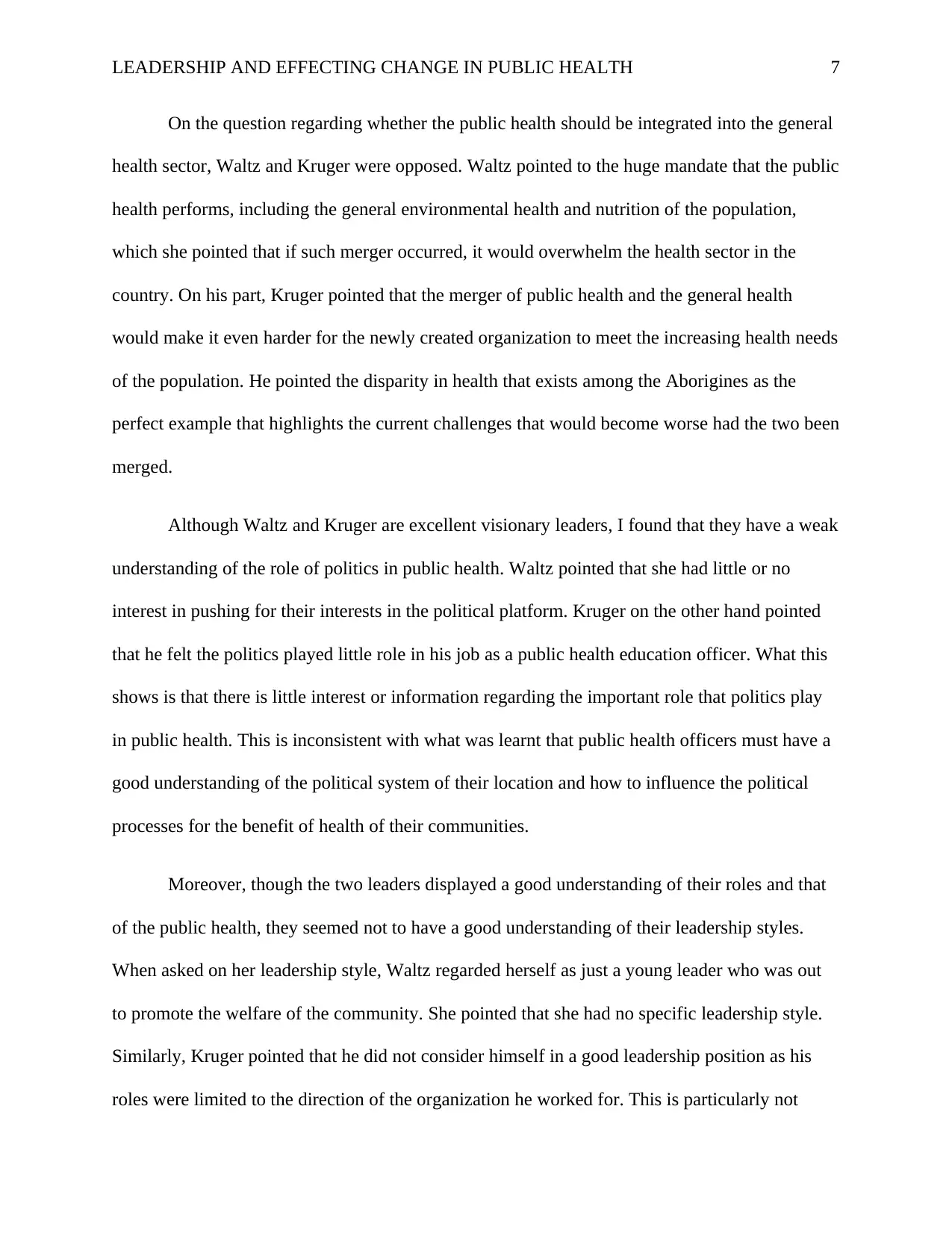
LEADERSHIP AND EFFECTING CHANGE IN PUBLIC HEALTH 7
On the question regarding whether the public health should be integrated into the general
health sector, Waltz and Kruger were opposed. Waltz pointed to the huge mandate that the public
health performs, including the general environmental health and nutrition of the population,
which she pointed that if such merger occurred, it would overwhelm the health sector in the
country. On his part, Kruger pointed that the merger of public health and the general health
would make it even harder for the newly created organization to meet the increasing health needs
of the population. He pointed the disparity in health that exists among the Aborigines as the
perfect example that highlights the current challenges that would become worse had the two been
merged.
Although Waltz and Kruger are excellent visionary leaders, I found that they have a weak
understanding of the role of politics in public health. Waltz pointed that she had little or no
interest in pushing for their interests in the political platform. Kruger on the other hand pointed
that he felt the politics played little role in his job as a public health education officer. What this
shows is that there is little interest or information regarding the important role that politics play
in public health. This is inconsistent with what was learnt that public health officers must have a
good understanding of the political system of their location and how to influence the political
processes for the benefit of health of their communities.
Moreover, though the two leaders displayed a good understanding of their roles and that
of the public health, they seemed not to have a good understanding of their leadership styles.
When asked on her leadership style, Waltz regarded herself as just a young leader who was out
to promote the welfare of the community. She pointed that she had no specific leadership style.
Similarly, Kruger pointed that he did not consider himself in a good leadership position as his
roles were limited to the direction of the organization he worked for. This is particularly not
On the question regarding whether the public health should be integrated into the general
health sector, Waltz and Kruger were opposed. Waltz pointed to the huge mandate that the public
health performs, including the general environmental health and nutrition of the population,
which she pointed that if such merger occurred, it would overwhelm the health sector in the
country. On his part, Kruger pointed that the merger of public health and the general health
would make it even harder for the newly created organization to meet the increasing health needs
of the population. He pointed the disparity in health that exists among the Aborigines as the
perfect example that highlights the current challenges that would become worse had the two been
merged.
Although Waltz and Kruger are excellent visionary leaders, I found that they have a weak
understanding of the role of politics in public health. Waltz pointed that she had little or no
interest in pushing for their interests in the political platform. Kruger on the other hand pointed
that he felt the politics played little role in his job as a public health education officer. What this
shows is that there is little interest or information regarding the important role that politics play
in public health. This is inconsistent with what was learnt that public health officers must have a
good understanding of the political system of their location and how to influence the political
processes for the benefit of health of their communities.
Moreover, though the two leaders displayed a good understanding of their roles and that
of the public health, they seemed not to have a good understanding of their leadership styles.
When asked on her leadership style, Waltz regarded herself as just a young leader who was out
to promote the welfare of the community. She pointed that she had no specific leadership style.
Similarly, Kruger pointed that he did not consider himself in a good leadership position as his
roles were limited to the direction of the organization he worked for. This is particularly not
Paraphrase This Document
Need a fresh take? Get an instant paraphrase of this document with our AI Paraphraser
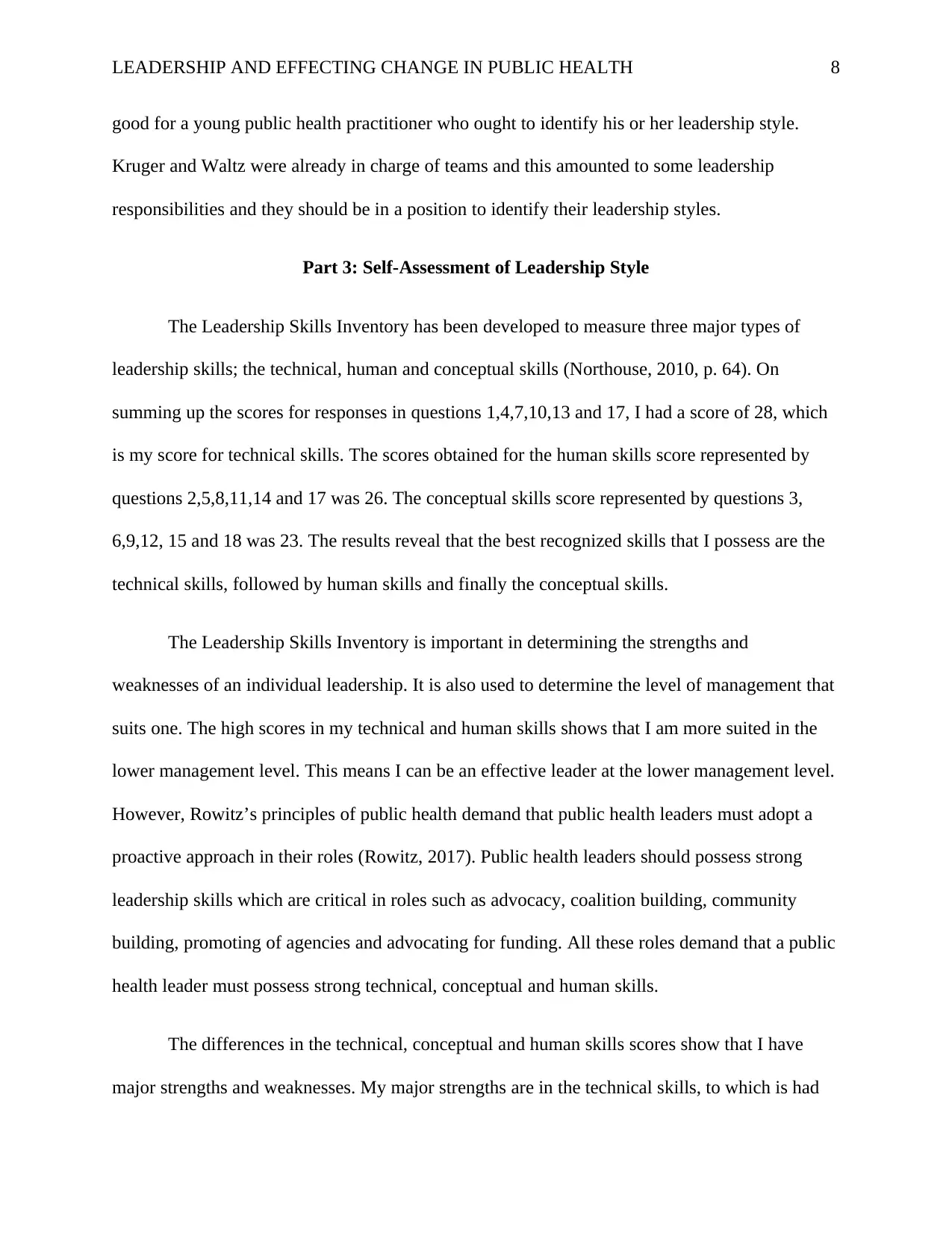
LEADERSHIP AND EFFECTING CHANGE IN PUBLIC HEALTH 8
good for a young public health practitioner who ought to identify his or her leadership style.
Kruger and Waltz were already in charge of teams and this amounted to some leadership
responsibilities and they should be in a position to identify their leadership styles.
Part 3: Self-Assessment of Leadership Style
The Leadership Skills Inventory has been developed to measure three major types of
leadership skills; the technical, human and conceptual skills (Northouse, 2010, p. 64). On
summing up the scores for responses in questions 1,4,7,10,13 and 17, I had a score of 28, which
is my score for technical skills. The scores obtained for the human skills score represented by
questions 2,5,8,11,14 and 17 was 26. The conceptual skills score represented by questions 3,
6,9,12, 15 and 18 was 23. The results reveal that the best recognized skills that I possess are the
technical skills, followed by human skills and finally the conceptual skills.
The Leadership Skills Inventory is important in determining the strengths and
weaknesses of an individual leadership. It is also used to determine the level of management that
suits one. The high scores in my technical and human skills shows that I am more suited in the
lower management level. This means I can be an effective leader at the lower management level.
However, Rowitz’s principles of public health demand that public health leaders must adopt a
proactive approach in their roles (Rowitz, 2017). Public health leaders should possess strong
leadership skills which are critical in roles such as advocacy, coalition building, community
building, promoting of agencies and advocating for funding. All these roles demand that a public
health leader must possess strong technical, conceptual and human skills.
The differences in the technical, conceptual and human skills scores show that I have
major strengths and weaknesses. My major strengths are in the technical skills, to which is had
good for a young public health practitioner who ought to identify his or her leadership style.
Kruger and Waltz were already in charge of teams and this amounted to some leadership
responsibilities and they should be in a position to identify their leadership styles.
Part 3: Self-Assessment of Leadership Style
The Leadership Skills Inventory has been developed to measure three major types of
leadership skills; the technical, human and conceptual skills (Northouse, 2010, p. 64). On
summing up the scores for responses in questions 1,4,7,10,13 and 17, I had a score of 28, which
is my score for technical skills. The scores obtained for the human skills score represented by
questions 2,5,8,11,14 and 17 was 26. The conceptual skills score represented by questions 3,
6,9,12, 15 and 18 was 23. The results reveal that the best recognized skills that I possess are the
technical skills, followed by human skills and finally the conceptual skills.
The Leadership Skills Inventory is important in determining the strengths and
weaknesses of an individual leadership. It is also used to determine the level of management that
suits one. The high scores in my technical and human skills shows that I am more suited in the
lower management level. This means I can be an effective leader at the lower management level.
However, Rowitz’s principles of public health demand that public health leaders must adopt a
proactive approach in their roles (Rowitz, 2017). Public health leaders should possess strong
leadership skills which are critical in roles such as advocacy, coalition building, community
building, promoting of agencies and advocating for funding. All these roles demand that a public
health leader must possess strong technical, conceptual and human skills.
The differences in the technical, conceptual and human skills scores show that I have
major strengths and weaknesses. My major strengths are in the technical skills, to which is had
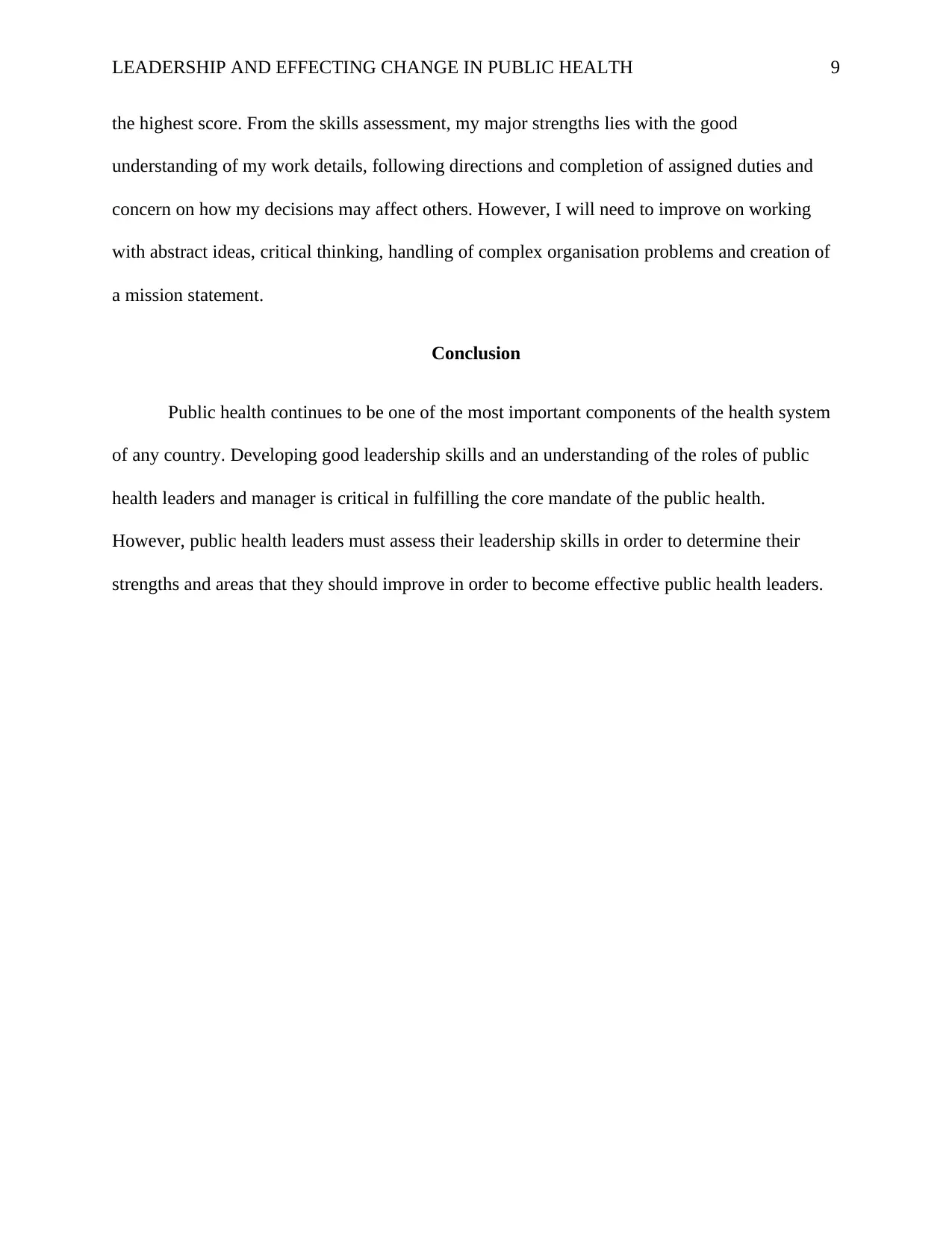
LEADERSHIP AND EFFECTING CHANGE IN PUBLIC HEALTH 9
the highest score. From the skills assessment, my major strengths lies with the good
understanding of my work details, following directions and completion of assigned duties and
concern on how my decisions may affect others. However, I will need to improve on working
with abstract ideas, critical thinking, handling of complex organisation problems and creation of
a mission statement.
Conclusion
Public health continues to be one of the most important components of the health system
of any country. Developing good leadership skills and an understanding of the roles of public
health leaders and manager is critical in fulfilling the core mandate of the public health.
However, public health leaders must assess their leadership skills in order to determine their
strengths and areas that they should improve in order to become effective public health leaders.
the highest score. From the skills assessment, my major strengths lies with the good
understanding of my work details, following directions and completion of assigned duties and
concern on how my decisions may affect others. However, I will need to improve on working
with abstract ideas, critical thinking, handling of complex organisation problems and creation of
a mission statement.
Conclusion
Public health continues to be one of the most important components of the health system
of any country. Developing good leadership skills and an understanding of the roles of public
health leaders and manager is critical in fulfilling the core mandate of the public health.
However, public health leaders must assess their leadership skills in order to determine their
strengths and areas that they should improve in order to become effective public health leaders.
⊘ This is a preview!⊘
Do you want full access?
Subscribe today to unlock all pages.

Trusted by 1+ million students worldwide
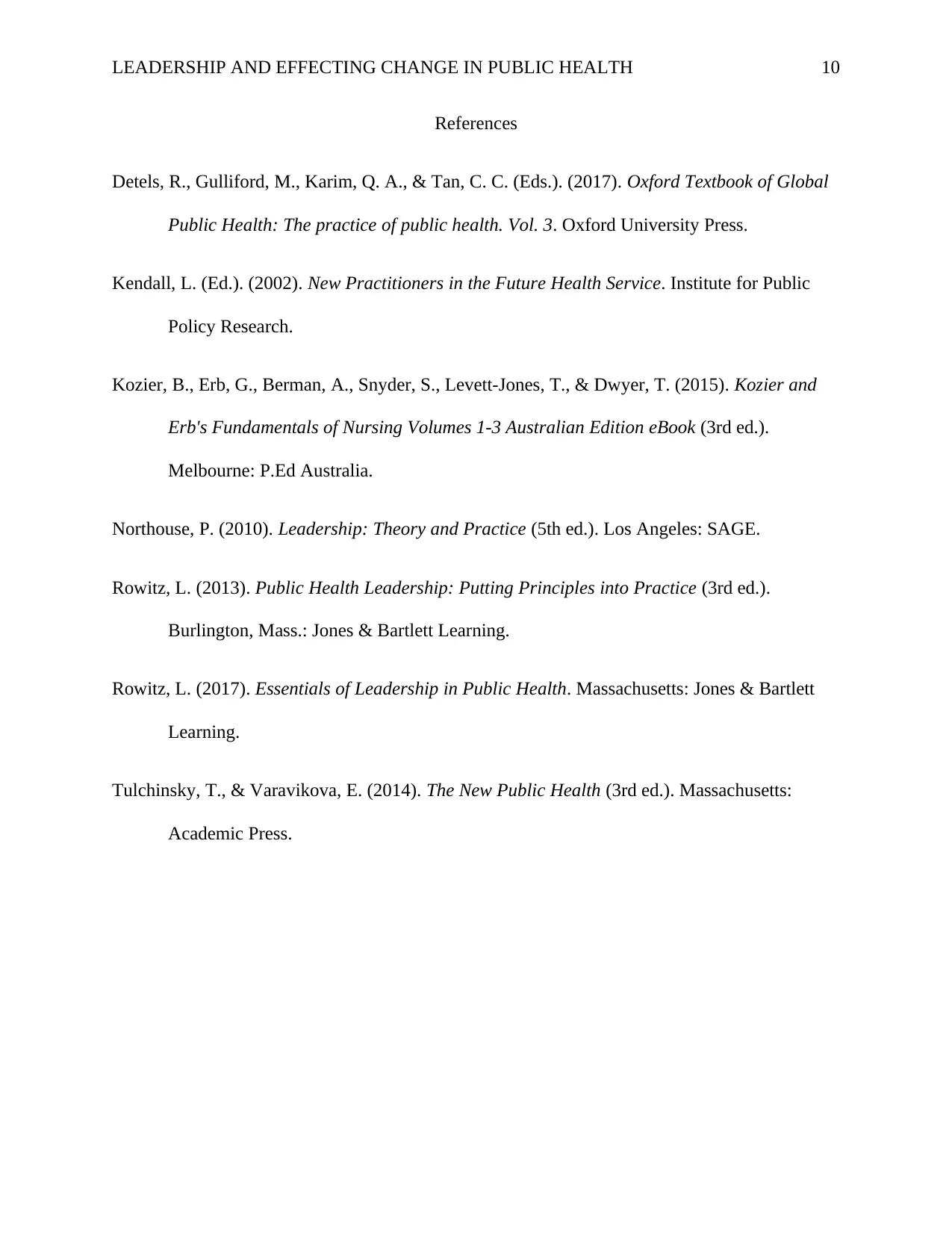
LEADERSHIP AND EFFECTING CHANGE IN PUBLIC HEALTH 10
References
Detels, R., Gulliford, M., Karim, Q. A., & Tan, C. C. (Eds.). (2017). Oxford Textbook of Global
Public Health: The practice of public health. Vol. 3. Oxford University Press.
Kendall, L. (Ed.). (2002). New Practitioners in the Future Health Service. Institute for Public
Policy Research.
Kozier, B., Erb, G., Berman, A., Snyder, S., Levett-Jones, T., & Dwyer, T. (2015). Kozier and
Erb's Fundamentals of Nursing Volumes 1-3 Australian Edition eBook (3rd ed.).
Melbourne: P.Ed Australia.
Northouse, P. (2010). Leadership: Theory and Practice (5th ed.). Los Angeles: SAGE.
Rowitz, L. (2013). Public Health Leadership: Putting Principles into Practice (3rd ed.).
Burlington, Mass.: Jones & Bartlett Learning.
Rowitz, L. (2017). Essentials of Leadership in Public Health. Massachusetts: Jones & Bartlett
Learning.
Tulchinsky, T., & Varavikova, E. (2014). The New Public Health (3rd ed.). Massachusetts:
Academic Press.
References
Detels, R., Gulliford, M., Karim, Q. A., & Tan, C. C. (Eds.). (2017). Oxford Textbook of Global
Public Health: The practice of public health. Vol. 3. Oxford University Press.
Kendall, L. (Ed.). (2002). New Practitioners in the Future Health Service. Institute for Public
Policy Research.
Kozier, B., Erb, G., Berman, A., Snyder, S., Levett-Jones, T., & Dwyer, T. (2015). Kozier and
Erb's Fundamentals of Nursing Volumes 1-3 Australian Edition eBook (3rd ed.).
Melbourne: P.Ed Australia.
Northouse, P. (2010). Leadership: Theory and Practice (5th ed.). Los Angeles: SAGE.
Rowitz, L. (2013). Public Health Leadership: Putting Principles into Practice (3rd ed.).
Burlington, Mass.: Jones & Bartlett Learning.
Rowitz, L. (2017). Essentials of Leadership in Public Health. Massachusetts: Jones & Bartlett
Learning.
Tulchinsky, T., & Varavikova, E. (2014). The New Public Health (3rd ed.). Massachusetts:
Academic Press.
1 out of 10
Related Documents
Your All-in-One AI-Powered Toolkit for Academic Success.
+13062052269
info@desklib.com
Available 24*7 on WhatsApp / Email
![[object Object]](/_next/static/media/star-bottom.7253800d.svg)
Unlock your academic potential
Copyright © 2020–2025 A2Z Services. All Rights Reserved. Developed and managed by ZUCOL.





